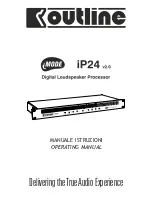
Appendix III
LE3000S
29
Tone Generation
The Model 3000S retains all digital audio format and sample rate settings when generating a tone. The
output tone may be sent to an any AES/EBU or SPDIF device. Use of a quality reference D/A converter
allows for listening for various effects (distortions, channel separation, room and speaker cabinet
vibrations and more). The output of device(s) or setup under test may be applied back to Model 3000S
inputs for the following reasons:
•
Accurate level settings via the internal reference meter bridge
•
Measurement of THD+N.
•
Measurement of tone frequency and amplitude.
Regardless of the functions performed (sample rate conversion, Acoustic Bit Correction, metering, or any
of the format conversion tasks) the unit provides for quick and easy insertion or substitution of digital audio
signals with test tones. The unit resumes "normal operation" when exiting tone generation mode.
The test tone screen enables setting tone characteristics:
•
Frequency: 1 Hz to 20 kHz in 1 Hz steps
•
Amplitude: 0 dB (full scale) to -99 dB in 1 dB steps
•
Destination: Right channel, Left channel or both
Test tone "quality":
Tones purity at maximum word length (22-24 bits) exceeds full scale performance of 122 dB for all
frequencies.
Consumer data format dictates 16 bits. Professional mode allows generation of 16 to 24 bits. Note that
while you may set the word length as desired, shorter words mean increased distortions and noise
(119 dB for 20 bits, 110 dB for 18 bits and 98 dB for 16 bits). Distortion performance improves for lower
amplitudes.
Transfer rate settings (main screen) are retained:
When main screen is set to "BYPASS", output data (audio data or tone) is transmitted synchronously to
input data.
Selection of one of the internal crystal oscillators (44100, 48000, 88200, or 96000). provides stand-alone
tone generation.
Содержание 3000S
Страница 2: ......

































